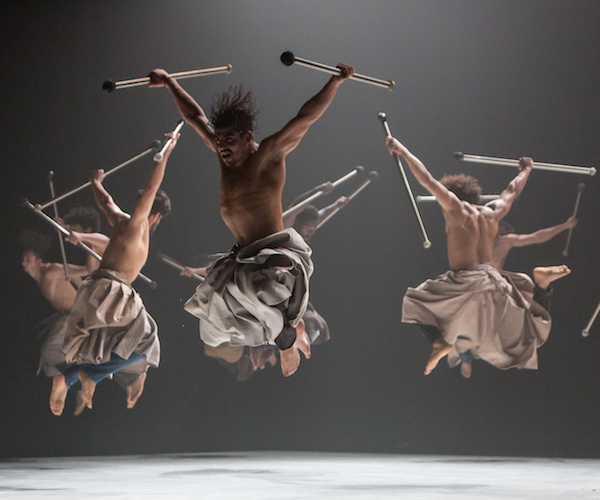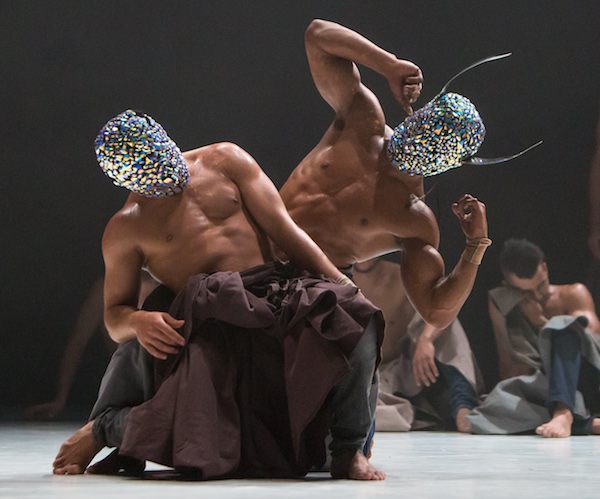Dance Review: Compagnie Hervé Koubi — Looping through the Categories
Performance has always included sex and physicality in its attractions. Koubi’s work tries to move the spectators to a higher level.
Compagnie Hervé Koubi in Les nuits barbares ou les premier matins du monde. Presented by World Music/CRASHarts at the Institute of Contemporary Art, Boston, on January 13.

A scene from Compagnie Hervé Koubi’s “Les nuits barbares ou les premier matins du monde.” Photo: Frédéric de Favernay.
By Marcia B. Siegel
Multiculturalism is a good thing. After last week’s outburst from the White House, who can disagree with that? Certainly no one in the audience at the ICA Saturday night. Hervé Koubi, whose Cannes-based company of dancing acrobats was performing, believes that different nationalities and cultural practices can not only meet but meld together. His 2015 work Les nuits barbares . . . (The Barbarous Nights, or the First Dawns of the World) was having its only Boston performance. On Friday Koubi’s other piece, Ce que le jour doit à la nuit, was a repeat of the dance he brought here two years ago. Both works incorporated hip hop, sufi spinning, martial arts, and modern dance, with a bare-chested all-male company. Audiences adored them.
Les nuits barbares began in the dark, with spacey music and mysterious moving points of light. As the stage lighting slowly came up, we could make out a cluster of bodies. After a time, the seething group was revealed to be a dozen or so men, their lower bodies wrapped in burlap-like cloths, with blue leggings underneath. Still later we discovered that their heads were completely encased in globes, covered with silvery round objects, that reflected the overhead stage lights as they moved. (The masks were designed by Swarovski Elements.) When the group separated we could see that each helmet had long, sharp objects like donkey’s ears sprouting from the crown.
Eventually the ears disappeared from the masks and became weapons, like long knives, and the men engaged in simulated combats. Groups collected on each side of the space and I thought they would stage a gang fight, but instead one or more of them performed flips, cartwheels, somersaults, spins and other phenomenal tricks while others watched. One man could change from one standing leg to the other while spinning. Another man, spinning on his head, could upend his legs in the air, changing their positions without interrupting the spin.
Whatever Koubi may have asserted about the word Barbare, I took it to mean barbarian, or uncivilized, not barbarous. The men’s movement — crouched, wary — hinted at an animalistic primitivism. They charged around the space and gathered again in earthbound clusters like a feral pack. At the same time they’d be reaching out with artfully curved arms and hands. This movement, contradicting their expert acrobatics, looked really strange. The deliberate slowness of the walking-around, and the pointedly pretty hands and arms, made them look so artificial, so androgynous.
I started thinking of the piece as an incarnation of the time-honored “Dance of the Ages” trope, in which performers enact supposed stages in the history of mankind. The events could have suggested the development of attachments and hostilities, ritual sacrifices, implied resurrections, and levitating ascensions to spirituality. The most significant changes happened very slowly, allowing the viewer to imagine many meanings before an action resolved. At other times the scene changed abruptly, as if the participants didn’t need to bother working up a transition.
I remember several images vividly. The pack swarmed around one man with their knives and engaged in a simulated attack. (No one actually struck anyone in all the evening’s aggressions.) When they moved out of the surrounding gang, the victim was spinning upside down on his head, with rectangular silvery objects flying out from his waist.
In another session, the men tossed batons with rubber tips to each other and seemed about to twirl them like cheerleaders. They could construct designs by holding the batons in geometric patterns. Later, a standing man in the midst of a swirling crowd was discovered in a sort of cage the others had built around him out of the batons, their acts of entrapping him hidden in plain sight.
Koubi isn’t ashamed to resort to devices from other genres. Batons, for instance, can be used in exercise training classes as well as the circus. Les nuits barbares had many sleight-of-hand actions — appearances and disappearances, transformations, comings and goings — in which the mechanics were hidden by groups of dancers tightly or frenetically concealing the magic’s machinery. Paul Taylor uses this device too, sparingly. Besides the skillful designs and multipurposed props, Koubi and his designers created costume and stage effects to enhance this evolution.

A scene from Compagnie Hervé Koubi’s “Les nuits barbares ou les premier matins du monde.” Photo: Frédéric de Favernay.
Les nuits barbares is accompanied almost continuously by bits of music. Some of it was from the European classical tradition (Wagner, Mozart and Fauré), some was electronically created or doctored, and some of it sounded like Middle Eastern folk music. There was virtually no dancing that matched any of this music, unless it might have been the invented idiom of the electronics. When the folk music was playing, we didn’t see any corresponding folk dance. The Koubi dances are not metrically regular the way folk dance is, but they’re based on the phrasing of the movement’s kicks and flips, irregular, like speech phrasing.
The intensity escalated as the piece continued for over an hour. The feats got trickier and the walkarounds cohered more toward unison. Three men would lift another man; eventually groups of five or six were tossing someone in the air and catching him. By the end, large groups were hoisting a man to their shoulders and carrying him on their backs. When the last liftee rose straight up on the backs of his comrades and fell straight forward, to be caught just above the floor by four or five other men, the Kyrie from Gabriel Fauré’s Requiem was heard. That made him the third martyr of the dance, and I wondered, how did he come to die at the hands of his comrades while hearing a Catholic Mass?
What struck me about this piece was a preciousness that didn’t have to do with design, or religion, but, actually, sex. The audience certainly got off on those shapely male bodies and the phenomenal tricks they could do. Performance has always included sex and physicality in its attractions. Koubi’s work tries to move the spectators to a higher level.
Internationally known writer, lecturer, and teacher Marcia B. Siegel covered dance for 16 years at The Boston Phoenix. She is a contributing editor for The Hudson Review. The fourth collection of Siegel’s reviews and essays, Mirrors and Scrims—The Life and Afterlife of Ballet, won the 2010 Selma Jeanne Cohen prize from the American Society for Aesthetics. Her other books include studies of Twyla Tharp, Doris Humphrey, and American choreography. From 1983 to 1996, Siegel was a member of the resident faculty of the Department of Performance Studies, Tisch School of the Arts, New York University.
